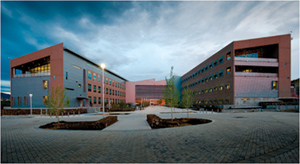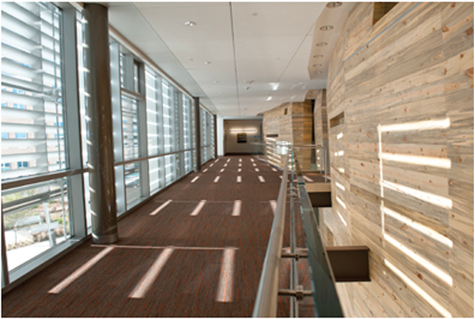When people consider a large office building that potentially generates as much energy as is uses, they may assume it would require only the most advanced technologies. Wouldn’t the building have to incorporate methods and technologies not available to the general public? Those assumptions are being proven wrong with the U.S. Department of Energy’s (DOE) new Research Support Facility (RSF) on the campus of the National Renewable Energy Lab (NREL) in Golden, Colo. The RSF is expected to become the first U.S. office building to generate as much energy as it uses, thanks to a combination of old and new technologies used to achieve that goal.

Eric Escudero
Senior Public Affairs Specialist
U.S. Department of Energy
The process of constructing a new building on the NREL campus began in 1995. Many DOE employees were in leased space in Golden.
“It started as effort to reduce the amount of money we were spending on rent so we could devote more funds to research,” said Jeff Baker, the Director of Laboratory Operations for DOE in Golden. “We looked at cost of a lease compared to cost of constructing a new building. When we did the financial comparison, it was overwhelming that we should have our own building.”
Federal funding for construction was not obtained until 2006. Once funding was approved, the goals became more accessible.
“We wanted a walk-the-talk building, so we had to do the best we could to demonstrate our design and knowledge for energy efficiency that would display the latest technologies for energy efficiency in a commercial building,” said Baker. “We were driven by a need for a mission. It had to financially look good. Also, NREL did not have a brand. We needed to establish that NREL was the nation’s premier research and development organization and be recognized as such with investments that have been made.”
About 800 employees are expected to work in the 222,000 square foot building, which was completed this past June (2010). It was a daunting task to design and construct an ultra energy efficient building that large. Yet some of the technology used in the new RSF to achieve this unprecedented level of energy efficiency has been available for hundreds of years.
“Many people are surprised when they walk into a cathedral on a hot day and feel how cool it is,” said Tom Hootman with RNL, the design company responsible for this innovative project. One of the keys to efficiency is thermal mass, such as large amounts of concrete, masonry and stone. Those elements in the RSF lead to a large amount of heat absorbed, which is the same concept used in very old cathedrals,” he explained.
Thin Design
A very “thin” building design is another old concept used to save energy in the RSF…
“Each wing is only 60 feet wide,” said Byron Haselden, President of Haselden Construction, the builder DOE chose to do the construction. “Many buildings before World War I were built using this same strategy. They had to be easily and naturally ventilated. Both sides of the RSF are connected so the building can breathe,” Haselden said.
This narrow building design also enables day lighting. Building orientation minimizes east and west glazing, and reduces unwanted heat losses and gains.
The sun played a major part in making the RSF so energy efficient. Most of the lights stay off during the workday because 100 percent of the workstations are day-lit. This is possible because each workstation is no more than 30 feet from a window. Daylight enters the upper portions of the south-facing windows and is reflected to the ceilings and deep into the space.
“We wanted to use every bit of free energy from the climate that we could,” Hootman continued. “To do that, we were interested in getting the day lighting to work for the entire building.”
“Open Windows” Architecture
Perhaps the most popular feature among employees working at the RSF is that they have the option to open and close many windows. This is a feature rarely offered in most office buildings yet it helps cool the building and eliminates the need for air conditioning. The RSF also has a 1.6 megawatt roof solar system, which combined with the building’s energy-efficient technology and design, creates the opportunity to generate as much energy as is used.
A labyrinth thermal storage space, which looks like an underground maze of concrete, occupies the RSF’s lower crawl space. The labyrinth stores thermal energy and provides additional capacity for passive heating of the building.
Advanced technology also played a major role in creating the RSF. During the warm summer months, windows will open automatically at night to vent excess heat. As a result of the cool nighttime air, the concrete walls lose their heat. This is a process that repeats itself throughout the warm months. It’s one of the reasons the ultra-energy efficient building has no need for a traditional forced air system.
The western side of the building typically gets the most direct sunshine throughout the year. As a result, there was a concern that the excess sunlight could provide an additional need for cooling. To counter this challenge, electrochromic windows were installed. The electro-chromic windows automatically tint to reduce heat, which makes a big difference in reducing electricity. The RSF also features advanced elevators that use magnets instead of electricity to stay ready for use and further reduce energy consumption in the building.

Recycled Beetle Boards
Another aspect of the building that makes it unique is the amount of recycled materials used in the construction. Reclaimed natural gas pipes are used as building columns so materials used for traditional energy sources are being used to reduce energy use in the futuristic building. Wood from trees killed by a beetle infestation in the Rocky Mountain forests is used in a decorative lobby entry and recycled materials from Denver’s closed Stapleton Airport were used as aggregate in foundations and slabs. Haselden Construction recycled 75 percent of the building’s construction waste.

The Funding Challenge
Getting funding for this ambitious project was quite a challenge; delivering the vision for one of the most energy efficient office buildings in America was even harder. It took an entirely different approach to design and construct.
“It’s one of the most challenging projects we have ever done,” said Haselden. “Energy usage was considered in every step of the design and construction. We had to take a design and build approach in which we created (energy) performance goals, then design and build to meet those performance criteria.”
One of the major goals for the RSF was to create an ultra-energy efficient building that can be easily duplicated. If energy use in buildings across the United States is reduced than businesses can reap the economic benefit. However, when a one-of-a-kind-building is created there are challenges to documenting the entire scope of innovation and development.
“The reason it was a formidable challenge to document everything during the RSF construction and design process was that we were innovating every step of the way,” said Baker. “Documenting everything is essential in a ground-breaking project like this because creating a how to manual for future project managers was one of our goals so similar buildings could be created.”
The RSF is considered a “living laboratory” because its energy usage will be studied and adjusted as part of DOE’s unrelenting efforts to improve energy efficiency across the United States. The early verdict on the building is it potential could change how new office buildings in America are constructed.
“What we have shown by completing this project is that it’s possible to create an office building that is ultra-energy efficient with advanced and older technologies,” said Baker. “More importantly, this building demonstrates that this can be done at costs comparable to traditional office buildings.”
Byron Haselden is just as optimistic in how the new building could affect the future of ultra-energy efficient construction…
“Some people have called the RSF the first of a new classification of real estate. I think that is accurate. This building is making history from the standpoint of size and different types of components used to make it so energy efficient.”
More detailed information is available on the DOE’s new RSF on the Internet. NREL has several feature stories detailing many more building aspects that make it so unique at www.nrel.gov/news/rsfnews/.
About the Author
Eric Escudero is a Senior Public Affairs Specialist at the U.S. Department of Energy’s office in Golden, Colorado. DOE-Golden, the lead organization under DOE’s Office of Energy Efficiency and Renewable Energy, plays a pivotal role in advancing and deploying clean energy technologies across the nation through laboratory collaboration, industry partnerships and business support. DOE-Golden also oversees the National Renewable Energy Laboratory (NREL), the only national lab dedicated to the research and development of energy efficiency and renewable energy technologies.







